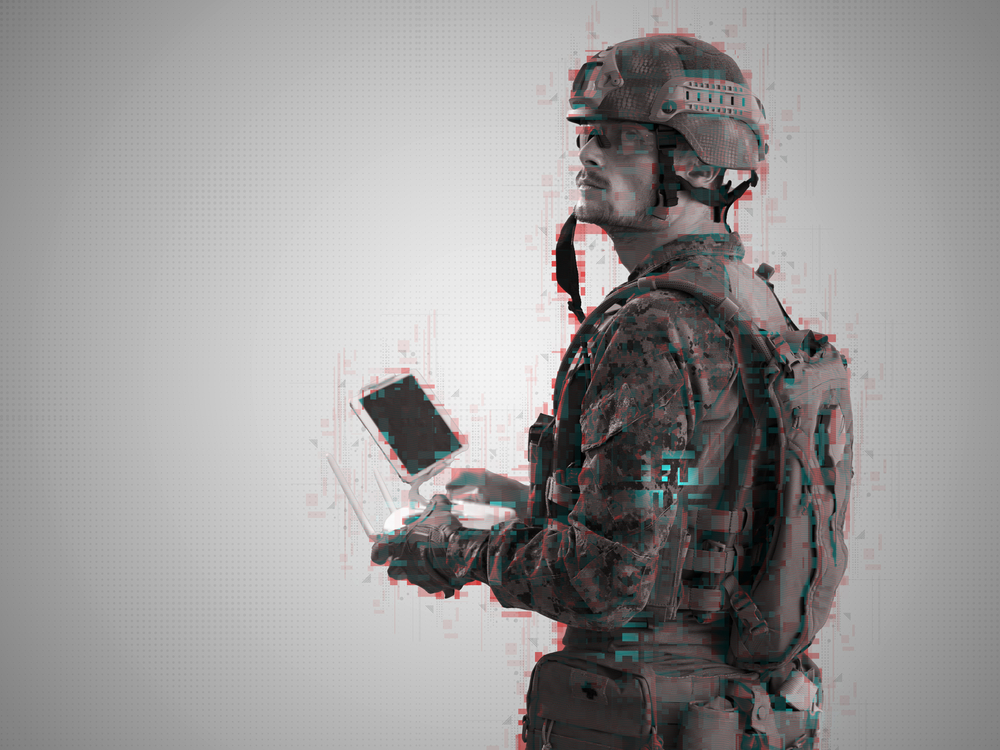The Pentagon’s Defense Innovation Unit (DIU) is looking for commercial solutions to develop wearable and handheld controllers that will allow soldiers to operate multiple types of unmanned vehicles.
With responses due by March 30, 2021, the Department of Defense (DoD) is seeking commercial solutions for the “prototyping and fielding of a Soldier Robotic Controller (SRoC) capable of controlling multiple types of robotic platforms, including both air and ground-based unmanned systems,” according to the DIU open solicitation.
Solution briefs for the Soldier Robotic Controller program should provide a detailed overview a proposed solution to one or more of the following controller configurations:
- Tactical Wearable: input device(s) that can be operably connected with an Android-based end user device to serve as a body-worn robotic control system. Companies may submit individual components of this configuration including joystick or gesture controllers, cables and interconnects, data link modularity solutions, and any other relevant subsystems, but not the display.
- Tactical Handheld: a handheld controller consisting of all required controller components in an easy to handle form, occupy <200 in^3 volume, and operate both with and without any external cables, wires, or power supply. The controller must demonstrate the ability to connect to USB compliant devices. The controller, without radio, should have a screen-on operating capability of at least 4 hours from a single charge. The controller should demonstrate at least an IP-53 rating. Companies should submit a description of the proposed solution’s gamepad type buttons, joysticks, and other physical control items integrated into and pluggable into the controller.
- Mounted: a hub capable of extending the peripherals of a handheld controller including additional displays, input/output devices, LAN connectivity, audio, and more. The hub should be capable of providing power via a power delivery port.
In October, 2018, the Defense Advanced Projects Agency (DARPA) kicked-off the OFFensive Swarm-Enabled Tactics (OFFSET) research program aimed at allowing small-unit infantry forces to interact with swarms of 250 small unmanned aircraft systems (UASs) and/or small unmanned ground systems (UGSs) in order to accomplish diverse missions in complex urban environments.
Throughout history, swarm tactics have been used by everyone from Genghis Khan and Alexander the Great and in major military operations up until the present day. The difference between the past and present is the rapid advancement in technology.
“In the future, we shall have to learn to fight nimbly against an array of armed adversaries who will likely do all they can to avoid facing us head-on in battle” — RAND
Swarming is a military tactic where a unit engages an adversary from all directions simultaneously, either with fire or in force, according to a report by the RAND National Defense Research Institute in 2005.
“For American political and military leaders, understanding the rise of swarming should lead to reappraisals of both our mass-oriented, industrial-age way of war, and of the statist focus of our diplomacy. In the future, we shall have to learn to fight nimbly against an array of armed adversaries who will likely do all they can to avoid facing us head-on in battle,” according to RAND.
Fast forward to March, 2021, and the Pentagon’s Defense Innovation Unit is looking for commercial solutions that will allow its soldiers to operate multiples types of unmanned air and land vehicles using wearable and handheld controllers.
Prior to the launch of the SRoC program, the DIU had previously called on the private sector to develop autonomous drones that could track people, vehicles, and weapons, as well as conduct 3D mapping, all while communicating with other AI systems in dark and congested areas.
“Signals from the brain can be used to command and control … not just one aircraft but three simultaneous types of aircraft” — DARPA
While the DIU’s current SRoC program is focused on wearable and handheld tech to control drones, the Pentagon has also been looking into brain-computer interfaces for piloting drones with noted success.
After years of research, trials, and major funding, DARPA announced in 2018 that a brain-computer interface had allowed for the telepathic piloting of drones.
“As of today, signals from the brain can be used to command and control … not just one aircraft but three simultaneous types of aircraft,” said Justin Sanchez, Director of the Biological Technologies Office at DARPA, at the Agency’s 60th-anniversary event in Maryland via Defense One on September 6, 2018.
“The signals from those aircraft can be delivered directly back to the brain so that the brain of that user [or pilot] can also perceive the environment. It’s taken a number of years to try and figure this out,” he added.
The Pentagon has funded research into many modern technologies such as the foundation for the Internet (ARPANET), GPS, and voice assistants like Alexa, Cortana, and Siri.
Will the Pentagon’s drone research make its way to the commercial sector as well?
DARPA envisions soldiers swarming with 250 robots simultaneously in urban combat
Brain-computer interface allows for telepathic piloting of drones
Drones that can see without being seen ‘at night, underground, in the Arctic, and in fog’: DARPA
US intelligence wants a super quiet spy drone for 10-pound payloads, military use











